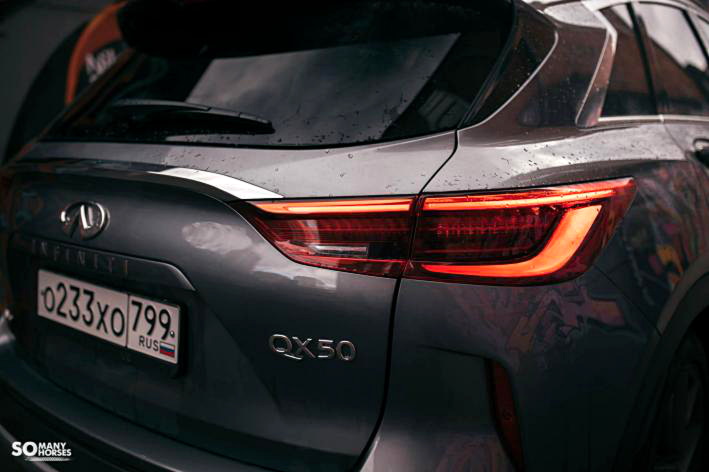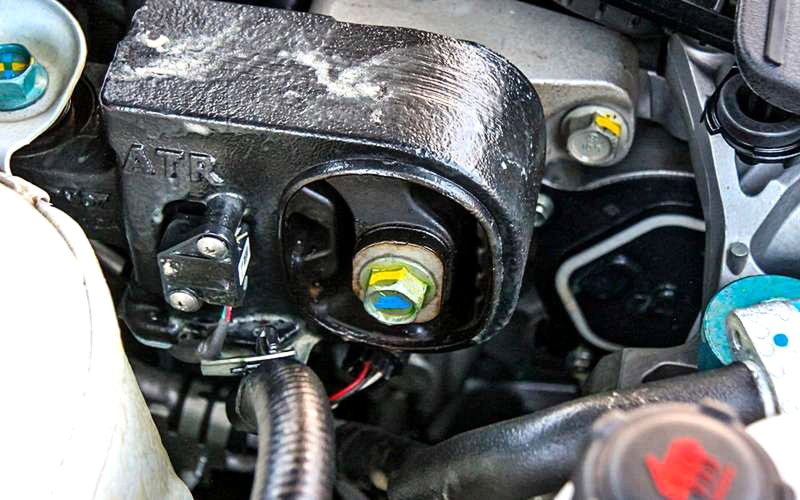Review Infiniti QX50 2018-2019
Material content
Ah… Has something changed?
In your memory, this will surely be the shortest review of the exterior of the car, because … In the updated Infiniti QX50, absolutely nothing has changed outwardly. All the same sloping body, massive grille, LED optics with a characteristic squint. You will not see any changes even if you download a million photos and try to find them with a magnifying glass (and I was looking, believe me).


Although not, perhaps one change can still be found by hitting a large-scale search – the range of available body colors for the novelty has increased thanks to a new brown tint: Mocha Almond with a metallic effect. But we have a dark gray car for a test drive, which is absolutely no different from its predecessor. What then has changed?
Video
How does it all ride?
To be honest, changing the compression ratio does not affect the movement of the car in any way.
Does it give at the start from a place? Despite considerable power, the motor responds to the gazulka with laziness. Perhaps the weight of the crossover … QX50, I tell you, the weight is not sickly, under two tons. Only after passing the mark “2” on the tachometer and “30” on the speedometer, you can feel a confident pickup. Then just watch the speedometer, because the speed is not felt at all while driving. Oops, it’s already 80 – we’re flying! The sound of the motor during a sharp increase in speed, by the way, is so-so. They could have done some magic with the exhaust, because there is a bifurcated muffler at the back like “how serious everything is”. From the old bass FX, only memories remained …
Strong enough
And without clarification from Infiniti representatives, it was obvious that innovative turbo engine before arriving in Russia, they deforce from 272 hp. up to tax-friendly 249 “horses”. This has become a rule of good taste even in the premium segment. Turn up the power a bit? Even the German Big Three do not disdain this. It happens that the return is rewritten only on paper and all the engine compartment “horses” remain in place. I compare the characteristics of the American and Russian versions of the QX50 and begin to believe in it.
 The engine mount at the right shock absorber cup is not simple. This is Infiniti’s patented Active Torque Rod (ATR) system, an electronically controlled assembly that dampens peak engine noise and vibration. It works especially effectively under intense acceleration in combination with the proprietary active noise cancellation system in the cabin – Active Noise Cancellation (ANC).The engine mount at the right shock absorber cup is not simple. This is Infiniti’s patented Active Torque Rod (ATR) system, an electronically controlled assembly that dampens peak engine noise and vibration. It works especially effectively under intense acceleration in combination with the proprietary active noise cancellation system in the cabin – Active Noise Cancellation (ANC).
The engine mount at the right shock absorber cup is not simple. This is Infiniti’s patented Active Torque Rod (ATR) system, an electronically controlled assembly that dampens peak engine noise and vibration. It works especially effectively under intense acceleration in combination with the proprietary active noise cancellation system in the cabin – Active Noise Cancellation (ANC).The engine mount at the right shock absorber cup is not simple. This is Infiniti’s patented Active Torque Rod (ATR) system, an electronically controlled assembly that dampens peak engine noise and vibration. It works especially effectively under intense acceleration in combination with the proprietary active noise cancellation system in the cabin – Active Noise Cancellation (ANC).
The peak power falls on the same 5600 rpm, the moment is the same in both cases – 380 Nm at 4400 rpm. But the dynamic characteristics are different. Overseas QX50 reaches 60 mph (96 km/h) in 6.3 seconds, its top speed is 230 km/h. In our specification, acceleration to the cherished hundred lasts 7.3 seconds, and the maximum speed is 10 km / h less. But even here not everything is so clear-cut. The measurements were carried out under different conditions. The “Russian” QX50 reported on the roads of the landfill, and not on laboratory running drums. Plus our car in the basic configuration, it is almost a hundredweight heavier: it has more options.
However, you should not regret the loss of 23 forces – there are enough dynamics for the eyes. Variable compression ratio does not give itself away. The average fuel consumption is 9.4 l / 100 km with a “vegetable” ride on the roads of Tatarstan hung with cameras with two people in the cabin. Acceptable, but nothing outstanding.
Body and interior
After the change of generations in 2017, the car has changed both in terms of the exterior and in terms of interior design. Creating a new generation of crossover, the designers focused on the QX50 concept, the exterior of which was built in accordance with the style, dubbed “Powerful Elegance”. Outside, the SUV began to look more menacing and even aggressive. Such changes were made possible by the narrowed head optics, as well as the radiator grill, made in the form of a trapezoid and trimmed with chrome. In addition, the manufacturer redesigned the front bumper, which incorporated rounded fog lights and a powerful air intake.

The interior of the crossover, as befits expensive models, is finished with high-quality materials, as well as stylish decor. A rather original solution here is the installation of two touchscreens at once on the center console, in which access to all the built-in systems and services of the car is concentrated. It should be noted that in the top modification of the crossover, a three-color interior trim option is available.

Specifications
| Automobile | |
| brand, model | Infiniti QX50 |
| Version | 2.0 Sensory PROACTIVE AWD |
| Production | Mexico |
| Year of issue | 2019 |
| Body | carrier |
| Type | station wagon |
| Class | midsize crossover |
| Number of doors | 5 |
| Number of seats | 5 |
| Engine | |
| Model | KR20DDET |
| Type | gasoline turbocharged, in-line with variable compression ratio |
| Location | front, transverse |
| Supply system | combined: distributed and direct injection |
| Number of cylinders/valves | 4/16 |
| Working volume, cm cube. | from 1970 to 1997 |
| Maximum power, l. With. (kW)/r/min | 249 (183)/5600 |
| Maximum torque, Nm / rpm | 380/4400 |
| Dynamic characteristics | |
| Maximum speed, km/h | 220 |
| Acceleration time to 100 km/h, s | 7.3 |
| Transmission | |
| Drive unit | permanent four-wheel drive |
| Transmission | variable speed drive |
| Suspension | |
| Front | independent, spring, McPherson |
| rear | independent, spring, multi-link |
| brakes | |
| front | disc ventilated |
| Rear | disc ventilated |
| Dimensions and weight | |
| Clearance, mm | 217.2–221 |
| Length/width/height, mm | 4693/2161/1678 |
| Wheel base, mm | 2800 |
| Tire size | 255/45 R20 |
| Curb weight, kg | 1 986 |
| Trunk volume, l | 565 |
| Fuel consumption | |
| City, l/100 km | 10.5 |
| Zagorodny, l/100 km | 7.6 |
| Combined cycle, l/100 km | 8.6 |
| Fuel tank volume, l | 60 |